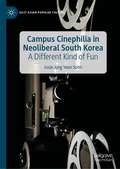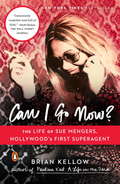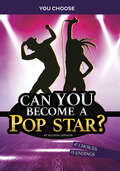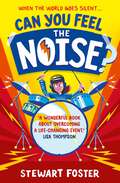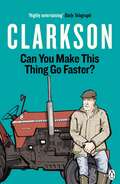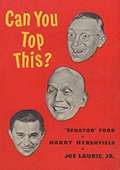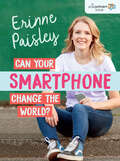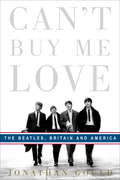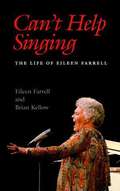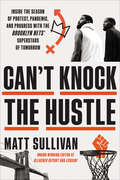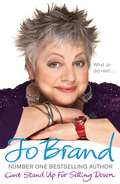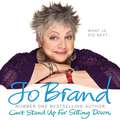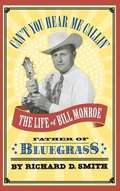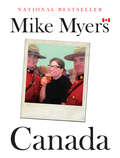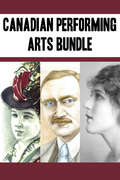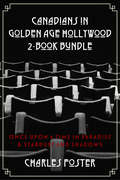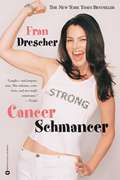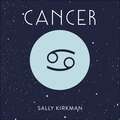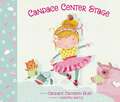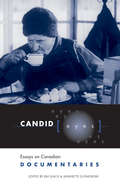- Table View
- List View
Campbell's 1-2-3 dinner
by Publications International Ltd.Most recipes involve three easy steps and make four servings. Flash Roasted Crispy Ranch Chicken--oh, so good! Polynesian Pork Chops--mmmm! Buffalo-Style Burgers--I think you are getting the picture: just reading this book will make you hungry. And, teens, when it is your turn to cook, you can't go wrong with the recipes and serving suggestions in this book.
Campus Cinephilia in Neoliberal South Korea: A Different Kind of Fun (East Asian Popular Culture)
by Josie Jung SohnTaking a transnational approach to the study of film culture, this book draws on ethnographic fieldwork in a South Korean university film club to explore a cosmopolitan cinephile subculture that thrived in an ironic unevenness between the highly nationalistic mood of commercial film culture and the intense neoliberal milieu of the 2000s. As these time-poor students devoted themselves to the study of film that is unlikely to help them in the job market, they experienced what a student described as ‘a different kind of fun’, while they appreciated their voracious consumption of international art films as a very private matter at a time of unprecedented boom in the domestic film industry. This unexpectedly vibrant cosmopolitan subculture of student cinephiles in neoliberal South Korea makes the nation’s film culture more complex and interesting than a simple nationalistic affair.
Can I Go Now?
by Brian KellowA lively and colorful biography of Hollywood's first superagent--one of the most outrageous showbiz characters of the 1960s and 1970s whose clients included Barbra Streisand, Ryan O'Neal, Faye Dunaway, Michael Caine, and Candice BergenBefore Sue Mengers hit the scene in the mid-1960s, talent agents remained quietly in the background. But staying in the background was not possible for Mengers. Irrepressible and loaded with chutzpah, she became a driving force of Creative Management Associates (which later became ICM) handling the era's preeminent stars.A true original with a gift for making the biggest stars in Hollywood listen to hard truths about their careers and personal lives, Mengers became a force to be reckoned with. Her salesmanship never stopped. In 1979, she was on a plane that was commandeered by a hijacker, who wanted Charlton Heston to deliver a message on television. Mengers was incensed, wondering why the hijacker wanted Heston, when she could get him Barbra Streisand.Acclaimed biographer Brian Kellow spins an irresistible tale, exhaustively researched and filled with anecdotes about and interviews more than two hundred show-business luminaries. A riveting biography of a powerful woman that charts show business as it evolved from New York City in the 1950s through Hollywood in the early 1980s, Can I Go Now? will mesmerize anyone who loves cinema's most fruitful period.
Can I Go Now?: The Life of Sue Mengers, Hollywood's First Superagent
by Brian Kellow"To call Sue Mengers a 'character' is an understatement, unless the word is written in all-caps, followed by an exclamation point and modified by an expletive. And based on Brian Kellow's assessment in his thoroughly researched Can I Go Now? even that description may be playing down her personality a bit." --Jen Chaney, The Washington Post* A NY Times Culture Bestseller * An Entertainment Weekly Best Pop Culture Book of 2015 * A Booklist Top Ten Arts Book of 2015 *A lively and colorful biography of Hollywood's first superagent--one of the most outrageous showbiz characters of the 1960s and 1970s whose clients included Barbra Streisand, Ryan O'Neal, Faye Dunaway, Michael Caine, and Candice BergenBefore Sue Mengers hit the scene in the mid-1960s, talent agents remained quietly in the background. But staying in the background was not possible for Mengers. Irrepressible and loaded with chutzpah, she became a driving force of Creative Management Associates (which later became ICM) handling the era's preeminent stars.A true original with a gift for making the biggest stars in Hollywood listen to hard truths about their careers and personal lives, Mengers became a force to be reckoned with. Her salesmanship never stopped. In 1979, she was on a plane that was commandeered by a hijacker, who wanted Charlton Heston to deliver a message on television. Mengers was incensed, wondering why the hijacker wanted Heston, when she could get him Barbra Streisand.Acclaimed biographer Brian Kellow spins an irresistible tale, exhaustively researched and filled with anecdotes about and interviews more than two hundred show-business luminaries. A riveting biography of a powerful woman that charts show business as it evolved from New York City in the 1950s through Hollywood in the early 1980s, Can I Go Now? will mesmerize anyone who loves cinema's most fruitful period.From the Hardcover edition.
Can You Become a Pop Star?: An Interactive Adventure (You Choose: Chasing Fame and Fortune)
by Allison LassieurDo you dream of belting out a chart-topping single on stage in front of thousands of people? Even with talent and determination, it’s a long, winding journey to the top. Chart your path to stardom, facing real-life choices as you go. Some choices may lead to center stage, while others lead to disappointment or redirection into another career field.
Can You Feel the Noise?
by Stewart FosterA profound story about inner strength and perseverance in the face of a life-changing event, from the award-winning author of The Bubble Boy. Perfect for fans of R. J. Palacio's Wonder and Lisa Thompson's The Goldfish Boy.&‘A wonderful book about overcoming a life-changing event and the remarkable power of music.&’ – Lisa Thompson, author of The Goldfish BoyLife is going well for Sophie. She&’s getting by at school, has some pretty awesome friends, and their band have made it through to the semifinals of the Battle of the Bands competition.But when Sophie wakes up completely deaf one morning, the life she once knew seems like a distant memory. With lessons replaced by endless hospital appointments, and conversations now an exercise in lip-reading, Sophie grows quieter and quieter. Until she discovers the vibrations of sound through an old set of drums and wonders whether life onstage is actually still within reach.Drawing on the author's own hearing impairment, Can You Feel the Noise? is a deeply personal and moving story that will stay with you long after reading.Praise for Can You Feel the Noise? &‘Powerful, moving and uplifting. This beautifully-told story highlights the gift of perseverance.&’ – Polly Ho-Yen, author of Boy in the Tower &‘A moving, empathy-boosting, and hopeful story about a young musician navigating hearing loss.&’ – Rashmi Sirdeshpande, author of Think Like a Boss 'A sensitive and brilliant story of hearing loss, full of humour and hope.&’ – A. M. Howell, author of The Garden of Lost Secrets
Can You Make This Thing Go Faster?
by Jeremy ClarksonThe hilarious new collection of stories and observations from Jeremy Clarkson - setting our off-kilter world to rights with thigh-slapping wit once again.Who is that tractor-driving Gentleman Farmer?Has Jeremy turned into a horny-handed son of the soil?These and other perplexing questions may or may not be answered in the latest volume of Clarkson's utterly unbiased musings on life, the universe and everything in between (except cars - this isn't one of his four-wheel drive books).Inside you'll also discover why:· Bathing in crude oil isn't for everyone· People who go fishing hate their kids· Noise-cancelling headphones will never silence James May· The rambler who stole his marrow is in for itFull of fact-checked opinions and ideas so good they're no longer following the science but chasing it up a tree, Can You Make This Thing Go Faster? is one hundred per cent guaranteed Clarkson . . .Praise for Clarkson:'Brilliant . . . laugh-out-loud' Daily Telegraph'Outrageously funny . . . will have you in stitches' Time Out'Very funny . . . I cracked up laughing on the tube' Evening Standard
Can You Top This?
by Senator Ed Ford Harry Hirschfield Joe Laurie Jr.You know this trio of gagsters. They’re heard twice weekly, over the NBC national hookup on Fridays, and over station WOR every Wednesday night.Here, sifted from thousands of their best, is the very cream of their jets. Most of these stories broke the Laughmeter as studio audiences howled with delight. Even if you’ve heard some of them before, you’ll love the new twist these experts have given them.Just to add to the general hilarity of the book, thumbnose sketches of each other have been written by those versatile gentlemen, and a further attraction, they have thrown in cartoons too.One word of warning before you open CAN YOU TOP THIS? Don’t blame us if you laugh yourself sick.
Can Your Smartphone Change the World? (PopActivism #1)
by Erinne PaisleyCan Your Smartphone Change the World? is a twenty-first-century guide for anyone who has access to a smartphone. This how-to manual looks at specific ways you can create social change through the tap of a screen. Filled with examples of successful hashtag campaigns, viral videos and new socially conscious apps, the book provides practical advice for using your smartphone as a tool for social justice. This is the first book in the PopActivism series. Can Your Outfit Change the World? comes out in spring 2018 and Can Your Conversations Change the World? in fall 2018.
Can't Buy Me Love: The Beatles, Britain and America
by Jonathan GouldNearly twenty years in the making, Can't Buy Me Love is a masterful work of group biography, cultural history, and musical criticism. That the Beatles were an unprecedented phenomenon is a given. In Can't Buy Me Love, Jonathan Gould seeks to explain why, placing the Fab Four in the broad and tumultuous panorama of their time and place, rooting their story in the social context that girded both their rise and their demise. Beginning with their adolescence in Liverpool, Gould describes the seminal influences--from Elvis Presley and Chuck Berry to The Goon Show and Alice's Adventures in Wonderland--that shaped the Beatles both as individuals and as a group. In addition to chronicling their growth as singers, songwriters, and instrumentalists, he highlights the advances in recording technology that made their sound both possible and unique, as well as the developments in television and radio that lent an explosive force to their popular success. With a musician's ear, Gould sensitively evokes the timeless appeal of the Lennon-McCartney collaboration and their emergence as one of the most creative and significant songwriting teams in history. And he sheds new light on the significance of Sgt. Pepper's Lonely Hearts Club Band as rock's first concept album, down to its memorable cover art. Behind the scenes Gould explores the pivotal roles played by manager Brian Epstein and producer George Martin, credits the influence on the Beatles' music of contemporaries like Bob Dylan, Brian Wilson, and Ravi Shankar, and traces the gradual escalation of the fractious internal rivalries that led to the group's breakup after their final masterpiece, Abbey Road. Most significantly, by chronicling their revolutionary impact on popular culture during the 1960s, Can't Buy Me Love illuminates the Beatles as a charismatic phenomenon of international proportions, whose anarchic energy and unexpected import was derived from the historic shifts in fortune that transformed the relationship between Britain and America in the decades after World War II. From the Beats in America and the Angry Young Men in England to the shadow of the Profumo Affair and JFK's assassination, Gould captures the pulse of a time that made the Beatles possible--and even necessary. As seen through the prism of the Beatles and their music, an entire generation's experience comes astonishingly to life. Beautifully written, consistently insightful, and utterly original, Can't Buy Me Love is a landmark work about the Beatles, Britain, and America. From the Hardcover edition.
Can't Help Singing: The Life of Eileen Farrell
by Eileen Farrell Brian KellowEileen Farrell is blessed with two voices. A classically-trained dramatic soprano who also loves to belt pop songs and torch the blues, she successfully conquered the worlds of opera and popular music over the course of her whirlwind career. Now, Farrell shares reminiscences about her remarkable professional and personal life. With candor, humor, and affection, she recalls her New England childhood, her overnight success at age twenty as star of her own CBS radio show, her big break dubbing vocals for Eleanor Parker in the MGM movie Interrupted Melody, and her many guest appearances on television shows. Farrell discusses her rise to fame as an opera star, from her highly acclaimed performance in Medea in 1955, to her historic debut at the Metropolitan Opera in Alceste in 1960. She also fondly recollects her marriage of forty years to New York police officer Robert Reagan and her life outside the limelight, including her frustrating tenure as a faculty member at Indiana University. Farrell speaks frankly about her tumultuous years at the Met, where her head-to-head confrontations with Sir Rudolph Bing brought her promising operatic career to an abrupt close after five seasons. While she loved singing the music of Verdi, Mascagni, and Giordano, Farrell reveals that she never reconciled herself to the life of a diva, preferring the friendliness of show business to the aloofness of the opera world. Populated with such figures as Leonard Bernstein, Arturo Toscanini, Maria Callas, Ethel Merman, Mabel Mercer, and Carol Burnett, this engaging memoir takes the reader from backstage at the Met to behind-the-scenes of the Ed Sullivan Show, providing a fascinating view of opera and the entertainment industry. Eileen Farrell's legion of fans will delight in her inviting story of a career that was like no other singer's.
Can't Knock the Hustle: Inside the Season of Protest, Pandemic, and Progress with the Brooklyn Nets' Superstars of Tomorrow
by Matt Sullivan“Brilliantly audacious…written with the profundity of a sage baller and the acuity of a seasoned journalist.”—Kiese Laymon, New York Times bestselling author of Heavy An award-winning journalist's behind-the-scenes account from the epicenter of sports, social justice, and coronavirus, Can't Knock the Hustle is a lasting chronicle of the historic 2019-2020 NBA season, by way of the notorious Brooklyn Nets and basketball's renaissance as a cultural force beyond the game.The Nets were already the most intriguing startup in the NBA: a team of influencers, entrepreneurs and activists, starring the controversial Kevin Durant and Kyrie Irving. But this dynasty-in-the-making got disrupted by the unforeseen. One tweet launched an international scandal, pitting the team's Chinese owner and the league's commissioner against its players and LeBron James. The sudden death of Kobe Bryant, after making his final public appearance in Brooklyn, sent shockwaves through a turbulent season.Then came the unimaginable. A global pandemic and a new civil-rights movement put basketball's trend-setting status to the ultimate test, as business and culture followed the lead of the NBA and its empowered stars. No team intersected with the extremes of 2020 quite like the Brooklyn Nets, and Matt Sullivan had a courtside view.Can't Knock the Hustle crosses from on the court, where underdogs confront A-listers like Jay-Z and James Harden, to off the court, as players march through the streets of Brooklyn, provoke Donald Trump at the White House, and boycott the NBA's bubble experiment in Disney World. Hundreds of interviews—with Hall-of-Famers, All-Stars, executives, coaches and power-brokers across the world—provide a backdrop of the NBA's impact on social media, race, politics, health, fashion, fame and fandom, for a portrait of a time when sports brought us back together again, like never before.
Can't Stand Up For Sitting Down
by Jo BrandThe Stand-Up while Sitting Down Years...Jo Brand is one of our best-loved comedians, according to a quote she made up. This memoir is full of hard-won wisdom, hilarity and her views on life, laughs, friendships and all the good and bad things in the world. If she was Prime Minister, the country would be in even more of a mess than it is.
Can't Stand Up For Sitting Down
by Jo BrandThe Stand-Up while Sitting Down Years...Jo Brand tells the story of how she crawled to fame and fortune, managed to persuade someone to marry her and had some children at an age when she should have been in a bath chair on the seafront. In this second volume of her memoirs, Jo recounts wild times on the comedy circuit, the attempts to tart her up for the TV screen, running the marathon, rally driving, her numerous, occasionally extremely inebriated, Edinburgh festival appearances, her 'acting' career, and much, much more.Jo Brand is one of our best-loved comedians, according to a quote she made up. This memoir is full of hard-won wisdom, hilarity and her views on life, laughs, friendships and all the good and bad things in the world. If she was Prime Minister, the country would be in even more of a mess than it is.(P)2010 Headline Digital
Can't You Hear Me Callin': The Life Of Bill Monroe, Father Of Bluegrass
by Richard A. SmithFrom the book jacket: Elvis Presley chose one of his songs, "Blue Moon of Kentucky," for his first single. A young Jerry Garcia traveled crosscountry to audition for his band. Johnny Cash, Buddy Holly, and even Frank Sinatra were fans. Considering the range of stars and styles that claim him as an influence, no single artist has had as broad an impact on American popular music as Bill Monroe. Born in 1911 in rural Kentucky, Monroe melded the fiddle tunes, ballads, and blues of his youth into the "high lonesome" sound known today as bluegrass, making him perhaps the only performer to create an entire musical genre. His distinctive bluegrass style profoundly influenced country, early rock 'n' roll, and the folk revival of the 1960s. A Grand Ole Opry star for almost sixty years, Monroe was a searing mandolinist who redefined the instrument, a haunting high-range vocalist, and a godlike figure to generations of admirers who became famous in their own right. When Monroe died in 1996, he was universally acclaimed as "the Father of Bluegrass," but the personal life of this taciturn figure remained largely unknown. His childhood feelings of isolation and abandonment- "lonesomeness" he called it-fueled his reckless womanizing in adulthood and inspired his most powerful compositions. From his professional breakthrough in the Monroe Brothers duet act to his bitter rivalry with former sidemen Lester Flatt and Earl Scruggs to his final days as a revered elder statesman of bluegrass, Monroe's career was filled with trials and triumphs. Now, veteran bluegrass journalist Richard D. Smith has interviewed a multitude of Monroe's surviving friends, lovers, colleagues, and contemporaries to create a three-dimensional portrait of this brilliant, complex, and contradictory man. Compel lingly narrated and thoroughly researched, Can't You Hear Me Callin' is the definitive biography of a true giant of American music. RICHARD D. SMITH is a journalist whose work has appeared in a number of national publications, including the NewYork Times, Bloomberg magazine, and the Journal of Country Music. The author of Bluegrass: An Informal Guide, he is also a reviewer for Bluegrass Unlimited magazine and plays mandolin and guitar. He lives in Rocky Hill, New Jersey.
Canada
by Mike MyersComedy superstar Mike Myers writes from the (true patriot) heart about his 53-year relationship with his beloved Canada. Mike Myers is a world-renowned actor, director and writer, and the man behind some of the most memorable comic characters of our time. But as he says: "no description of me is truly complete without saying I'm a Canadian." He has often winked and nodded to Canada in his outrageously accomplished body of work, but now he turns the spotlight full-beam on his homeland. His hilarious and heartfelt new book is part memoir, part history and pure entertainment. It is Mike Myers' funny and thoughtful analysis of what makes Canada Canada, Canadians Canadians and what being Canadian has always meant to him. His relationship with his home and native land continues to deepen and grow, he says. In fact, American friends have actually accused him of enjoying being Canadian--and he's happy to plead guilty as charged. A true patriot who happens to be an expatriate, Myers is in a unique position to explore Canada from within and without. With this, his first book, Mike brings his love for Canada to the fore at a time when the country is once again looking ahead with hope and national pride. Canada is a wholly subjective account of Mike's Canadian experience. Mike writes, "Some might say, 'Why didn't you include this or that?' I say there are 35 million stories waiting to be told in this country, and my book is only one of them." This beautifully designed book is illustrated in colour (and not color) throughout, and its visual treasures include personal photographs and Canadiana from the author's own collection. Published in the lead-up to the 2017 sesquicentennial, this is Mike Myers' birthday gift to his fellow Canadians. Or as he puts it: "In 1967, Canada turned one hundred. Canadians all across the country made Centennial projects. This book is my Centennial Project. I'm handing it in a little late. . . . Sorry."From the Hardcover edition.
Canadian Cinema Since the 1980s
by David L. PikeAward-winning author David L. Pike offers a unique focus on the crucial quarter-century in Canadian filmmaking when the industry became a viable force on the international stage. Pike provides a lively, personal, and accessible history of the most influential filmmakers and movements of both Anglo-Canadian and Quebecois cinema, from popular movies to art film and everything in between.Along with in-depth studies of key directors, including David Cronenberg, Patricia Rozema and Denys Arcand, Jean-Claude Lauzon, Robert Lepage, Léa Pool, Atom Egoyan, and Guy Maddin, Canadian Cinema since the 1980s reflects on major themes and genres and explores the regional and cultural diversity of the period. Pike positions Canadian filmmaking at the frontlines of a profound cinematic transformation in the age of global media and presents fresh perspectives on both its local and international contexts. Making a significant advance in the study of the film industry of the period, Canadian Cinema since the 1980s is also an ideal text for students, researchers, and Canadian film enthusiasts.
Canadian Cultural Policy in Transition (Routledge Studies in Media and Cultural Industries)
by Devin BeauregardThis book offers a comprehensive overview of Canadian cultural policy and research, at a time of transition and redefinition, to establish a dialogue between conventional and emerging foundations. Taking a historical view, the book informs insights on current trends in policy and explores global debates underpinning cultural policy studies within a local context. The book first acknowledges what Canadian cultural policy research conventionally recognizes and refers to in terms of institutions, values, and debates, before moving on to take stock of the transformations that are continuing to reshape Canadian cultural policy in terms of values, orientations, actors, and institutions. With a focus on all levels of government-- federal, provincial, and local -- the book also centers on Indigenous arts policies and practices. This systematic and inclusive volume will appeal to academic researchers, graduate students, managers of arts and culture programs and institutions, and in the areas of cultural policy, public administration, political science, cultural studies, film and media studies, theatre and performance, and museum studies.
Canadian Performing Arts Bundle: Emma Albani / John Grierson / Mary Pickford
by Peggy Dymond Leavey Michelle Labrèche-Larouche Gary EvansPresenting three titles in the Quest Biography series that profiles prominent figures in Canada’s history. In these books we explore the lives of some Canadian pioneers in the world of performing arts. Profiled are: Mary Pickford, the silent screen star of the 1920s; Emma Albani, a classical singer who reached the heights of fame in Europe; and John Grierson, a filmmaker responsible for setting up the National Film Board of Canada. Includes: Emma Albani John Grierson Mary Pickford
Canadians in Golden Age Hollywood 2-Book Bundle: Once Upon a Time in Paradise / Stardust and Shadows
by Charles FosterRevisit Hollywood’s Golden Age with insider Charles Foster, who befriended the many Canadian stars that peppered the film sets. Foster reveals the stories of the amazing influence Canadians had in the early days of the film biz. Includes: Stardust and Shadows: Canadians in Early Hollywood A Hollywood insider brings together the stories of eighteen Canadians who were celebrities during Hollywood’s formative years. Once Upon a Time in Paradise: Canadians in the Golden Age of Hollywood During Hollywood’s Golden Age, a bevy of talented Canadians earned important roles in the motion picture industry.
Cancer Schmancer (Biography Ser.)
by Fran DrescherPart inspirational cancer-survival story, part memoir-as-a-laugh-riot, CANCER SCHMANCER picks up where Fran's last book, Enter Whining, left off. After the publication of that book, Fran's life launched into a downward spiral. She separated from a long and complicated relationship, her TV series started to slip in the ratings, and the health of her beloved dog Chester was failing fast. Then came the mysterious symptoms no doctor could explain. With her trademark sense of humor, Fran tells of her long search for answers and the cancer diagnosis that she ultimately beat. But not before a gold mine of insights were revealed to her about the importance of taking charge of your own health and recognizing what's most important in life.
Cancer: The Art of Living Well and Finding Happiness According to Your Star Sign
by Sally KirkmanYou are a Cancer. You are the home lover and memory keeper of the zodiac.The signs of the zodiac can give us great insight into our day-to-day living as well as the many talents and qualities we possess. But in an increasingly unpredictable world, how can we make sense of them? And what do they mean? This insightful and introductory guide delves deep into your star sign, revealing unique traits and meanings which you didn't know. Along the way, you will discover how your sign defies your compatibility, how to improve your health and what your gifts are. ***The Pocket Astrology series will teach you how to live well and enhance every aspect of your life. From friendship to compatibility, careers to finance, you will discover new elements to your sign and learn about the ancient art of astrology. Other audiobooks in the series include: Aries, Taurus, Gemini, Cancer, Leo, Virgo, Libra, Scorpio, Sagittarius,Capricorn, Aquarius, Pisces(P)2018 Hodder & Stoughton Limited
Canción del desierto
by Laekan Zea KempUna familia disfruta de la música nocturna del desierto tejano en esta historia de tradición y recuerdo de Laekan Zea Kemp, ganadora de una Mención de Honor Pura Belpré.Todo empieza con un suave golpeteo,cuando el tío Eduardo tamborilea con las manossobre sus polvorientos pantalones. Cuando el rubor del atardecer da paso a la noche en el desierto, emergen coyotes, cigarras y lechuzas, cada uno de ellos llamando a la luna. Observando desde su porche, la familia participa en la canción. Uno por uno, cada familiar ofrece sus tambores, flauta, maracas, cuerdas y voces. Cantan con los insectos, pájaros, serpientes y sapos; y cantan con sus antepasados, una audiencia que brilla entre las estrellas. Con cada rasgueo de instrumentos heredados, los recuerdos se renuevan y los familiares que han fallecido están vivos y cercanos de nuevo. Canción del desierto tararea y suena con toda la música que un porche y el desierto más allá de él pueden contener. El conmovedor texto de Laekan Zea Kemp, ganadora de una Mención de Honor Pura Belpré, baila a través de las encantadoras ilustraciones de Beatriz Gutiérrez Hernández. Los lectores se quedarán con la reconfortante sensación de que cuando la creatividad florece, el pasado nunca está fuera de su alcance y los vínculos importantes nunca se rompen.
Candace Center Stage
by Candace Cameron BureEvery child who loves to dance will surely get a &“kick&” out of Candace Center Stage, the heartwarming and hilarious tale of a girl who joyfully embraces the song and dance in her heart … even when she doesn&’t quite fit in at ballet class. Written by Candace Cameron Bure, New York Times bestselling author and star of the hit TV series Full House and Fuller House, this charming, laugh-out-loud picture book tells the story of a little girl who quickly realizes one thing after her mother signs her up for ballet lessons … she&’s no ballerina. As Candace moves and grooves across the floor, she topples all the ballerinas in her path. Her teacher, Miss Grace, tries to teach her proper ballet positions, but Candace is more interested in shakes and shimmies than plies and pas de bourrées. When disaster strikes during the big recital, can ungraceful Candace step up and save the day? Candace Center Stage:Is an adorable picture book that tells the story of a spirited dancer who doesn&’t quite fit in at ballet classEncourages children, especially boys and girls ages 4-8, to embrace who they areIs written by actress, producer and author Candace Cameron Bure, best known for her role as D.J. Tanner on Full House and Fuller House
Candid Eyes
by Jeannette Sloniowski Jim LeachBeginning in 1922, when Robert Flaherty filmed 'Nanook of the North' in Canada's Arctic, and encouraged by John Grierson and the federal government in 1939 when they created the National Film Board of Canada (NFB), documentaries have dominated Canada's film production and, more than any other form, have been crucial to the formation of Canada's cinematic identity.Surprisingly, there has been very little critical writing on this distinguished body of work. Candid Eyes: Essays on Canadian Documentaries not only addresses this oversight in the scholarly literature, but in doing so, it presents an exceptional collection of essays by some of Canada's best known film scholars. Focusing on works produced in French and English under the NFB umbrella, the fourteen essays discuss and critique such landmark documentaries as 'Lonely Boy' (1962), 'Pour la suite du monde' (1963), and 'Kanehsatake' (1993). Long awaited and much needed, this volume will be an indispensable companion for anyone seriously interested in Canadian film studies.

